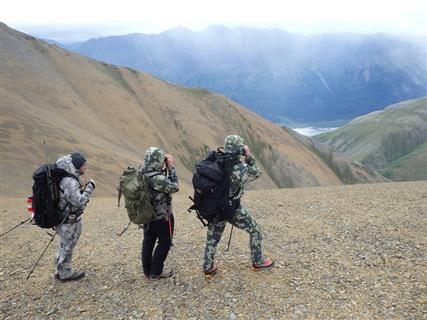Ovis Dallis
Our approach to sheep hunting is pretty basic. We make use of aerial scouting before the season gets started, and we attempt to locate rams, and bands of rams during this time in the air. After rams are spotted, we essentially make our decisions as to where we are going to locate spike camps. In essence, all of our camps are spike camps since we only utilize small two to four-man Hilleberg expedition tents, and for individuals accustomed to wall tents, they will have a hard time believing that any expedition tent could be considered a four-man tent. After making the decisions as to where we are going to hunt, we try to get in as close as possible to the area via a Super Cub, but we seldom land as close as we might like. It is not uncommon to hike, 2 to 6 miles from where we land to find a suitable place for a spike camp. Sheep are hunted from the spike camp, and if necessary the camp may be moved during a hunt to get into a better position to approach a given ram or group of rams. Occasionally we spend a night out on the slope, and we recommend a good quality survival bag for such events. Our hunts are true backpack hunts and we do hunt in our backpacks every day. While we typically carry only our essential gear, such as optics, cameras, butchering tools, and food supplies, the packs still typically weigh around 20 pounds during the hunt. The reasoning behind the constant use of the backpack, rather than a day pack, is the fact that no one ever wants to make additional trips to pack a harvested ram off the side of some hazardous slope, when it can be done in one trip with a hunter and guide both wearing a normal size pack.

The basic idea of the spike camp is to get as close as possible to the sheep without pressuring them into a move, thus enabling one to make a quality stalk if the opportunity presents itself. Our camps are lightweight and highly mobile, and we stick with the tried and true freeze dried meals by Mountain House to satisfy our appetites. Of course, we supplement the freeze-dried with instant oatmeal, trail mix, chocolate bars, summer sausages, cheese, and more. The idea is to get as many calories as possible into your body, every day, without having to pack 100 pounds of bulky foods. Getting a sufficient amount of calories while sheep hunting can be quite difficult, and it is not unusual to burn more calories than one takes in during the course of a day. For this reason, we encourage all our hunters to eat everything they can during a hunt, since it is not the appropriate time to diet, and a lack of calories can easily translate into a lack of energy at a crucial time on the stalk of a lifetime.
Days in spike camp usually start with instant oats, or Mountain House with a cup of coffee, or hot Tang, and some serious glassing. Our spike camps are located in areas that typically provide a good view of the surrounding slopes, and rams are routinely spotted from our camps, so we can never emphasize enough the need to use the binoculars. If rams are not spotted within a reasonable amount of time, we typically will travel far enough to get a different perspective or view of the surrounding mountains. Dall sheep that are bedded out of sight can easily appear out of seemingly nowhere, so it is important to routinely glass the same areas over and over again. Once a ram is spotted evaluations have to be made, and this can often be time-consuming on rams that are not obviously legal. Spotting scopes are brought out, and patience is often tried as we wait for a ram to give us a better view of its’ horns, and even then, it is sometimes necessary to make a climb, just to get a better look. Rams are occasionally spotted in areas that we simply cannot access, and sometimes you simply have to play the waiting game when this happens. When a ram is spotted in an area that appears accessible, then we begin the process of looking for a logical approach route. The ideal situation is one where you have the opportunity to come down on the ram or rams from above, however, this is often not possible, simply because rams have the tendency to remain in close proximity to very protective terrain, and this terrain is usually right above the areas they frequent for feeding. Dall sheep are quite unlike many big game species that the average hunter may have encountered before since they typically express little concern over the appearance of a human out at the 500 to 600-yard mark. This isn’t always the case of course, but I have often walked to within 500, even 400 yards of a ram, or group of rams, just to have them show no interest at all. Of course sheep notice you, but dependent upon the terrain that rams are found in, they often feel quite safe, even if you are close enough to take one down with the average rifle. Rams that have been pressured may react quite differently when they spot a hunter within shooting range, and without a doubt, a ram caught out in the open, with no good route of escape, well such a ram is not likely to ignore you. Our philosophy is to stay invisible as long as it is possible during a stalk, and hopefully, a ram will never know we were there at all. When this isn’t possible, we have been known to walk politely into the 400-yard range, set down, take a rest, and take a ram. Josh Spor’s 38 inch Chugach ram is an example of that technique working just fine.